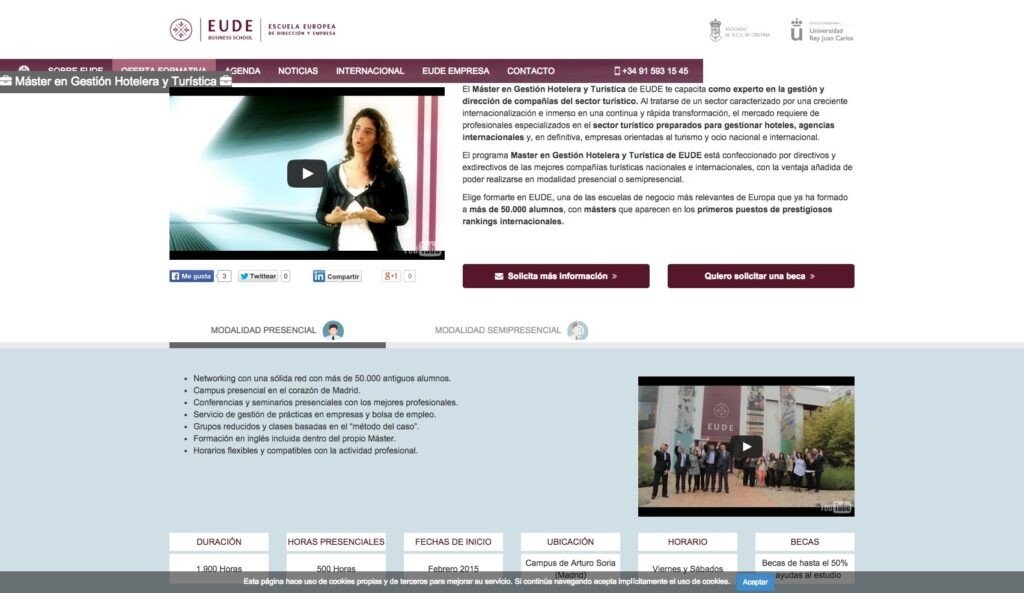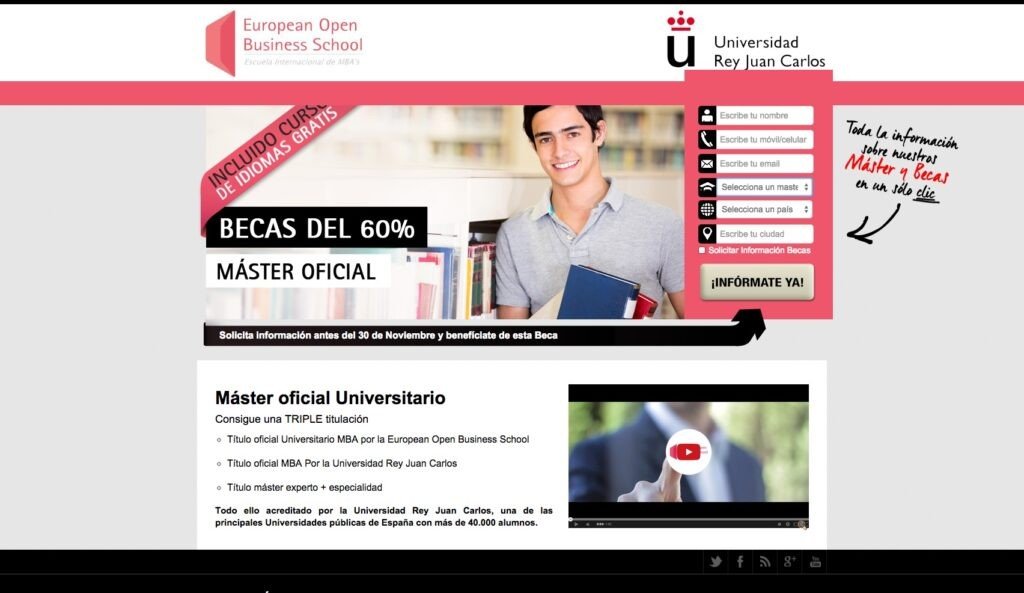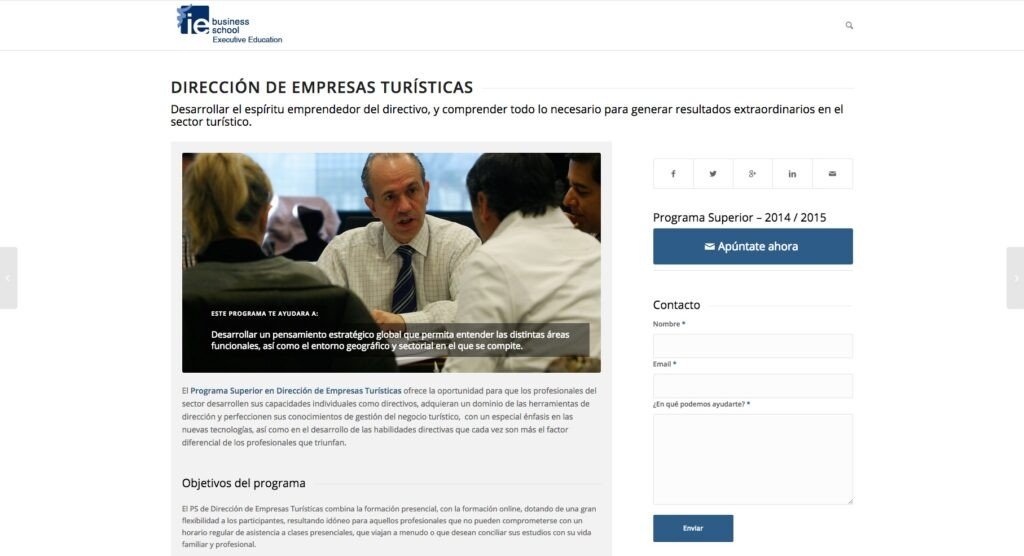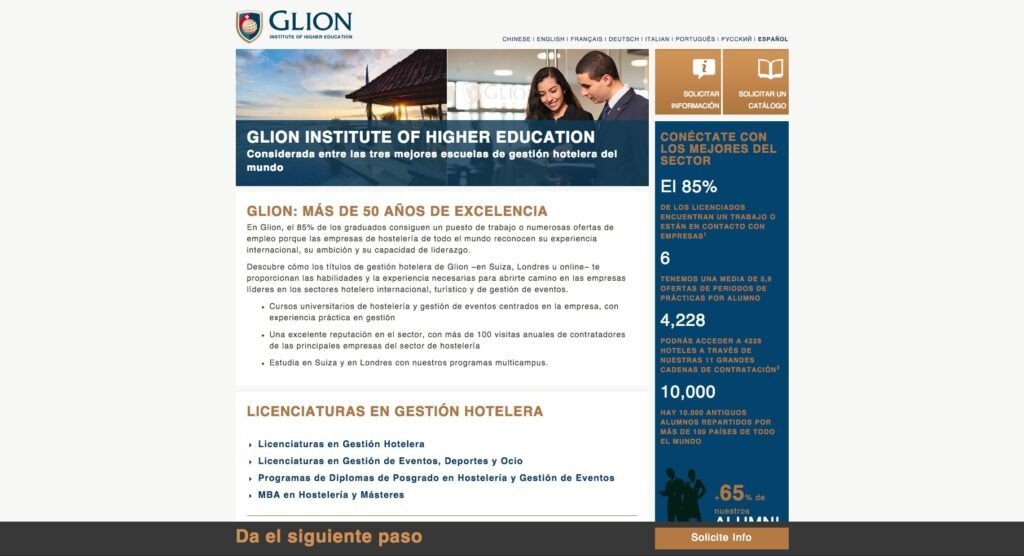Tipos de Landing Pages o Páginas de Aterrizaje para campañas PPC
En el artículo de hoy os vamos a explicar los tipos de landing pages o páginas de destino que existen para las Campañas de marketing digital y de publicidad online. Para ilustrar el post hemos realizado una búsqueda en España como ejemplo: «Máster en Turismo», donde los anunciantes emplean estrategias diferentes empleando las diferentes opciones de páginas de aterrizaje que existen.
1. Sitio corporativo primario como uno de los tipos de Landing Pages
Donde llegan todos los visitantes de todas las fuentes de tráfico independientemente del objetivo de cada uno de esos canales. No se hace diferencia por canal, es decir, los visitantes que llegan desde resultados orgánicos accederán al mismo contenido que los que llegan a través de campañas de Adwords o Facebook. Aquí ponemos el ejemplo de Máster en Turismo de EUDE.

Eude.es, Sitio web como un tipo Landing Page
2. Landing pages estancas específicas por escuela, curso o servicio
Una Landing Page o página de aterrizaje es una página web a la que llega un usuario, normalmente a través de un click en un enlace de una acción de marketing. Esta página web es una extensión de la comunicación de la acción, donde se explica más detalladamente la oferta del curso o servicio que se está comunicando o promocionando.
Las landing pages estancas tienen unas características de diseño muy concretas que, atendiendo a actitudes basadas en la psicología de los visitantes, limitan la profundidad de navegación a través un sitio corporativo. Facilitan que los visitantes se centren en el objetivo principal para el que se ha diseñado, que no es otro que llevar a cabo una acción como pedir una cita, una llamada o registrarse para recibir más información en diferentes formas. EOBS de la Universidad Rey Juan Carlos emplea una landing page no muy profunda. A pesar de ser una buena solución, no está enfocada al curso que hemos buscado por lo que sería mejorable.

Eobs; como tipo de Landing page estanca por curso de Máster
3. MicroSitio con varias páginas (múltiples Landing Pages)
Digamos que es un híbrido entre sitio corporativo y Landing pages. Permite mayor navegación por los contenidos de la escuela, pero siempre enfocada muy claramente al registro de los visitantes. Nunca se pierde el formulario de vista para el visitante, situándolo en la zona “above the fold” o por encima de la vista.
Los micrositios permiten estructurar la información de una manera más completa que la de una landing page y de una manera más simple que la de un sitio corporativo, ya que generalmente tienen un objetivo diferente al del sitio web primario. Un micrositio busca la capacidad de adaptar los contenidos y el diseño de una manera más dinámica.
El ejemplo que mostramos es del Instituto de Empresa, una de las mejores escuelas de negocio del mundo, también en cuanto a Marketing Digital se refiere.

IE; Micrositio como tipo de Landing Page.
4. Mono Sitio web continuo como uno de los tipos de landing pages
Podemos decir que este diseño ofrece la ilusión al usuario de que está en un sitio web con navegación con menús tradicionales, aunque realmente la información reside en un único html y el uso de los menús nos desplaza, de una manera suave, a una zona de la página web ya cargada en el navegador. Se puede utilizar para dar una mayor sensación de seriedad y de complejidad de los servicios ofrecidos mientras se mantiene la facilidad de navegación. El caso que presentamos de GLION no es completamente un ejemplo de Sitio Web continuo con Menú, pero se acerca bastante. Un ejemplo más cercano es nuestra web corporativa, pero para hacer el análisis comparativo, hemos querido emplear un ejemplo alineado con el resto.

GLION; Tipo de Landing Page con sub-menús
En Digital Menta analizamos las necesidades de nuestros clientes para diseñar la mejor solución, siempre orientada a maximizar los resultados de sus negocios.
En otro artículo te explicamos más profundamente las diferentes estrategias de Landing Pages en el Sector de la Educación y las ventajas e inconvenientes de cada una. ¡No te lo pierdas!



